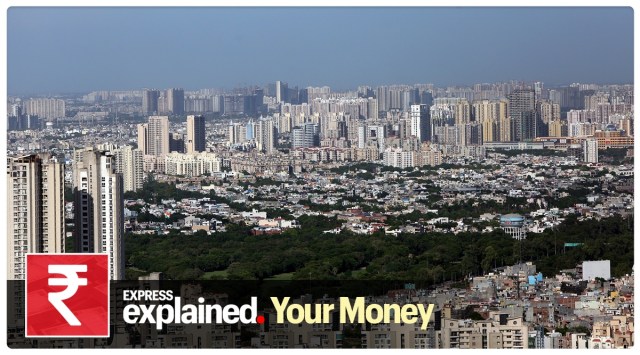How RBI rate hikes impact your home loan EMIs, and what can help
RBI MPC hikes repo rate: Since May 2022, EMIs have gone up by 19 per cent. What can borrowers do to reduce their financial burden? How will the rate hikes impact the housing market?
 The rate hikes could dent demand in the affordable housing segment. (Image source: Archives)
The rate hikes could dent demand in the affordable housing segment. (Image source: Archives) People with loans are set to witness a spike in their equated monthly instalments (EMIs) after the Reserve Bank of India jacked up the Repo rate – the key policy rate – by another 25 basis points to 6.50 per cent, taking the total hike to 250 bps and the rise in EMIs to 19 per cent since May 2022.
What loans will be the most impacted?
Although the rate hike will impact all types of borrowings, the rise will be immediate in the personal loan category, which, with an outstanding of over Rs 39.35 lakh crore, accounts for almost 29.8 per cent of the overall credit outstanding. Within this category, home loans account for almost 50 per cent of the outstanding – Rs 18.98 lakh crore, according to RBI data.
Interest rates of banks and finance companies are likely to go up with their cost of funds expected to rise post the Repo rate hike. EMIs on vehicles, homes, consumer durables, education, advances against fixed deposits and other personal loans will rise as the external benchmark linked lending rate (EBLR) of banks will go up by 25 bps — one basis point (bps) is one hundredth of a percentage point. As much as 43.6 per cent of the total loans are now linked to the Repo rate.
Marginal Cost of Funds-Based Lending rates (MCLR), which accounts for 49.2 per cent of the loans portfolio of banks, are also expected to move up. The Repo rate hike has already led to 60 per cent transmission into the lending rate.

What is the quantum of the hike?
If a customer had taken a home loan of Rs 50 lakh at 6.7 per cent for a 20-year period early last year, the EMI would have been Rs 37,870. As the rate is expected to be 9 per cent on an average (depending on the credit score of the borrower), following the latest Repo rate hike, the EMI would now become Rs 44,986, a jump of nearly 19 per cent, or Rs 7,116, in the last 9 months.
Similarly, for a Rs 25 lakh home loan at 6.7 per cent interest rate for 20 years, the current EMI would be Rs 22,493 as against Rs 18,935, a rise of Rs 3,558 in less than a year.
In December 2022, the RBI’s MPC hiked the Repo rate by 35 basis points in a bid to rein in retail inflation. The MPC hiked the repo rate by 40 bps in May and then by 50 bps in each of its three successive meetings.
“The increase in EMIs by around Rs 7,000 (on Rs 50 lakh loan) may have put a strain on some borrowers, but it has not dampened the overall demand for homes,” said Rohan Pawar, CEO, Pinnacle group.
What is the impact on tenure?
By the time the last repo rate hike was announced, home loan tenure had increased from 20 years to 33 years due to the rise in interest rates. “This means that if the borrower was 30 years old at the time of availing the home loan, the current increased loan tenure would already have surpassed their retirement age, and now lenders will ask for higher EMIs in most cases,” said Bhavik Thakkar, CEO of Abans Investment Managers Pvt Ltd.
What options do borrowers have?
One option before home loan borrowers is to ask their lender to increase spread (difference between MCLR and home loan rates offered to borrowers). “For borrowers with better credit scores, banks do consider increasing the spread – which means reduction in home loan rate – to retain their better customers. This can provide some respite and reduce the financial burden on borrowers,” Thakkar said.
Most home loan borrowers do not ask their lenders periodically if there is any scope to reduce interest rates by increasing the spread. Financial advisors and mutual fund distributors should educate their investors on this subject, Thakkar said.
According to Atul Monga, Founder and CEO, BASIC Home Loan, customers have the option to opt for a longer loan tenure. “This will reduce the monthly instalment, but the overall interest payments will be higher. Another option is to choose a floating interest rate. This type of rate is tied to market conditions, and if interest rates decrease, your EMI will decrease too.”
He said customers should make a higher down payment depending on their financial position. By paying a larger amount upfront, the loan amount and the EMI will be lower. “Customers should try to negotiate the interest rate with the lender to get a lower EMI. If you have a high interest rate loan, you can transfer the balance to another lender offering a lower rate and lower your EMI,” Monga said.
How will this impact the housing sector?
With the repeated hikes, the EMI-driven housing market will see a cumulative effect and the sales velocity will gradually be impacted in the coming months, industry officials said.
“The rising property prices had already made matters difficult for homebuyers, and now the RBI decision will temporarily dent the current demand momentum. For first-time home buyers, a home is considered the biggest asset, and these short-term moves are likely to have a major impact on the buyer’s decision,” said Himanshu Jain, VP, Sales, Marketing and CRM, Satellite Developers Pvt. Ltd. (SDPL).
“The higher home loan interest rate will be a deterrent in the affordable housing segment as it will impact the price-sensitive homebuyers and fatigue the supply of the developers. The luxury and mid-housing segment players, with a longer sales cycle, will remain cautious,” said Niranjan Hiranandani, National Vice Chairman, National Real Estate Development Council (NAREDCO).
Though the surplus liquidity will power credit growth in the real estate sector, demand economics is likely to be challenged in the affordable housing segment, which is the broad spectrum of the consumption pyramid.





- 01
- 02
- 03
- 04
- 05

































